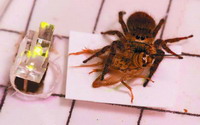作为性信号的萤火虫生物发光在吸引一些捕食者时,也使其他一些捕食者踌躇不前。
针对两种日行的、常见的捕食性蜘蛛:Phidippus princeps和Phidippus audax,我们测试了这种光是否具有反捕食功能。
为了证明白天在非交配的情况下萤火虫也发光,我们记录了成体雌雄萤火虫在白天受惊扰下发光的情况。
我们同时也证明了Phidippus和萤火虫的活动时间有部分重叠,证实了蜘蛛攻击萤火虫并引起发光行为。我们进行了三个实验以检验发光反应对蜘蛛行为的影响。
我们测试了LED突然闪烁是否会让袭击蟋蟀的蜘蛛受到惊吓,结果没有任何发现。我们进行了选择试验测试闪烁的灯光是吸引还是阻止蜘蛛攻击可口的猎物。
对于闪烁的LED和固定开或关的LED,蜘蛛更倾向于攻击在闪烁的LED边上的蟋蟀。许多萤火虫种类不是很可口,所以我们测试闪烁的灯光是否让捕食者凭经验避开不可口的猎物。
实验设计蜘蛛7次遇到不可口的猎物,变量是LED闪烁或是不亮。两种处理下,蜘蛛在第一次遇到猎物时都会进行攻击。但是在LED闪烁下的蜘蛛七次实验时明显不攻击不可口的猎物。
在LED闪烁下,蜘蛛对可口的蟋蟀攻击没有减弱。
所以我们得出结论,虽然生物发光信号可能会增加捕食者蜘蛛的攻击率,但是它们也会促使捕食者知道不可口的猎物。
因此,发光的好处与代价取决于萤火虫的可口性。(生物探索译)
相关英文论文摘要:
Firefly flashing and jumping spider predation
Bioluminescent flashing in fireflies, while primarily a sexual signal, is known to deter some predators while attracting others. We tested whether flashing serves an antipredator function against two species of diurnal, visually hunting jumping spiders, Phidippus princeps and Phidippusaudax. To confirm anecdotal reports that fireflies flash during the day in a nonmating context, we documented that adult fireflies (Photuris sp.) of both sexes flash when disturbed in daylight. We also confirmed that activity periods of Phidippus and fireflies overlap, and that spiders attack fireflies and elicit flashing behaviour. We conducted three experiments to examine the influence of flashing on spider behaviour. We tested whether the sudden onset of a flashing LED startled spiders that had initiated attacks on crickets, and found no evidence that it did so. We used choice tests to determine whether flashing lights attracted or deterred spiders from attacking palatable prey. Spiders more often attacked crickets positioned next to a flashing LED versus an LED that was either off or glowed steadily. Many firefly species are distasteful. Therefore, we tested whether flashing lights facilitate avoidance of unpalatable prey with experience. Spiders were given seven encounters with unpalatable prey (nonluminescent Ellychnia corrusca fireflies) associated with either flashing or unlit LEDs. Spiders in the two treatments were equally likely to attack the prey during their first encounter, but spiders exposed to flashing LEDs were significantly less likely to attack unpalatable prey by their seventh trial. Spiders tested with palatable prey showed no decline in attacks after exposure to flashing LEDs. We conclude that, although bioluminescent flash signals may increase attack rates by predatory jumping spiders, they may also facilitate learning about unpalatable prey. Thus, the costs and benefits of flashing may depend on the prevalence of firefly palatability.
英文论文链接:https://www.sciencedirect.com/science/article/pii/S0003347211004398








